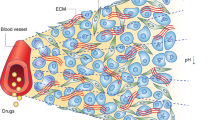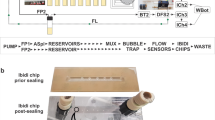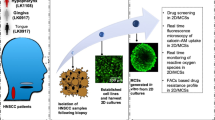Abstract
The poor blood supply to solid tumours introduces many factors that affect the outcome of chemotherapy, one of which is the problem of drug delivery to poorly vascularized regions of tumours. Whereas poor drug penetration has been recognized as a contributing factor to the poor response of many solid tumours, the question of drug penetration through multicell layers has not been thoroughly addressed, largely because of restrictions imposed upon these studies by the requirement for either radiolabelled or naturally fluorescent compounds. The aim of this study is to describe modifications made to a recently published assay that broadens the scope for assessing drug penetration during the early stages of drug development and to characterize the ability of various drugs to penetrate multicell layers. DLD-1 human colon carcinoma cells were cultured on Transwell-COL plastic inserts placed into 24-well culture plates so that a top and bottom chamber were established, the two chambers being separated by a microporous membrane. Drugs were added to the top chamber at doses equivalent to peak plasma concentrations in vivo and the rate of appearance of drugs in the bottom chamber determined by high-performance liquid chromatography (HPLC). Both 3-amino-1,2,4-benzotriazine 1,4-dioxide (tirapazamine) and 7-[4'-(2-nitroimidazol-1-yl)-butyl]-theophylline (NITP) rapidly penetrated DLD-1 multicell layers (50.9 +/- 12.1 microm thick) with t(1/2) values of 1.36 and 2.38 h respectively, whereas the rate of penetration of 5-aziridino-3-hydroxymethyl-1-methyl-2-[1H-indole-4,7-dione] prop-beta-en-alpha-ol (EO9) and doxorubicin through multicell layers was significantly slower (t(1/2) = 4.62 and 13.1 h respectively). Inclusion of dicoumarol increases the rate of EO9 penetration, whereas reducing the oxygen tension to 5% causes a reduction in tirapazamine penetration through multicell layers, suggesting that the extent of drug metabolism is one factor that determines the rate at which drugs penetrate multicell layers. The fact that EO9 does not readily penetrate a multicell layer, in conjunction with its rapid elimination in vivo (t(1/2) < 10 min), suggests that EO9 is unlikely to penetrate more than a few microm from a blood vessel within its pharmacokinetic lifespan. These results suggest that the failure of EO9 in the clinic is due to a combination of poor drug penetration and rapid elimination in vivo.
This is a preview of subscription content, access via your institution
Access options
Subscribe to this journal
Receive 24 print issues and online access
$259.00 per year
only $10.79 per issue
Buy this article
- Purchase on Springer Link
- Instant access to full article PDF
Prices may be subject to local taxes which are calculated during checkout
Similar content being viewed by others
Author information
Authors and Affiliations
Rights and permissions
About this article
Cite this article
Phillips, R., Loadman, P. & Cronin, B. Evaluation of a novel in vitro assay for assessing drug penetration into avascular regions of tumours. Br J Cancer 77, 2112–2119 (1998). https://doi.org/10.1038/bjc.1998.355
Issue Date:
DOI: https://doi.org/10.1038/bjc.1998.355
This article is cited by
-
Multilayered Cultures of NSCLC cells grown at the Air-Liquid Interface allow the efficacy testing of inhaled anti-cancer drugs
Scientific Reports (2018)
-
Cellular pharmacology studies of anticancer agents: recommendations from the EORTC-PAMM group
Cancer Chemotherapy and Pharmacology (2018)
-
Oleic acid incorporated gemcitabine-eluting stents for treatment of cholangiocarcinoma
Macromolecular Research (2017)
-
Size-Dependent Gold Nanoparticle Interaction at Nano–Micro Interface Using Both Monolayer and Multilayer (Tissue-Like) Cell Models
Nano-Micro Letters (2016)
-
Targeting the hypoxic fraction of tumours using hypoxia-activated prodrugs
Cancer Chemotherapy and Pharmacology (2016)



